The most frequent question I’ve heard since returning from the Cape Town International Jazz Festival (CTIJF) last week has been: “Why haven’t we seen any reports on the jazz?”
I’ve been writing about the reasons for a long time.
This is no failure of marketing or PR, but a shameful failure of the media, who have eviscerated serious arts coverage from almost all the platforms where South African music fans seek it. There is little page-space; there are few reporters – and what editors demand from them is “showbiz”. Which tells audiences nothing about the music.
Whatever alleged “trend experts” theorize, readers still enjoy reviews. If they were at the performance, they enjoy testing their opinions against someone else’s. If they weren’t, they can enjoy some vicarious experience – and maybe decide whether it’s worth attending next time.
The blogosphere acknowledges and meets that need. Blog reviews vary hugely in quality, but even the worst are voraciously consumed. Newspapers, despite their pressing business need to please, win and hold readers, choose to ignore it.
So, what was it like, there in Cape Town, as we struggled to get past shameful political behaviour and insults to departed heroes to give a fair hearing to the music?
Musically, it was probably one of the best festivals ever. The CTIJF’s multiple stages offer a fan many festivals in one. Mine largely revolves around the Rosie’s and Molelekwa stages, where the most interesting modern improvised music (reductively labelled ‘jazz’: a tag that obscures as much as it explains) happens.
The march of the philistines
What made the headlines was the so-called ‘riot’ outside the separately-ticketed Rosie’s venue where more people than the seats could hold wanted to hear Thandiswa Mazwai. It wasn’t quite a riot – unlike 2006, where the same thing happened before the late Miriam Makeba’s performance. The extremely perilous 2006 situation prompted the introduction of separate Rosie’s tickets. While I don’t see why a token R5 ticket would not serve the same purpose as the current R30 one, this year, ticketing proved its worth. No-one was trampled, and festival security filled all the seats and diverted the overflow efficiently, assisted by improved crowd control at the tops and bottoms of escalators. Frustrated, Mazwai-addicted fans may not care about any of this – but if it’s neglected, people can die.
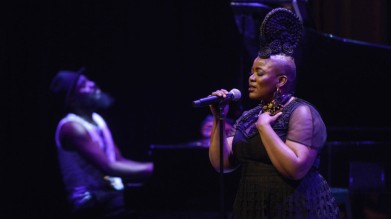
For those inside Rosie’s, what happened after that was equally distressing. Mazwai’s act merited the Rosie’s stage because her current show features intimate, personal singing and a sensitive jazz trio. It may seem perverse to have to assert this, but such music, lovingly created by skilled artists, is for listening. This seems to have been lost on sections of the crowd, who howled, chatted, selfie’d, phoned and ignored the music. They made life hell for those who wanted to listen. Many of those philistines were in the seats reserved for sponsors.
The problem the festival still hasn’t solved
This highlights the festival’s most important remaining structural problem. There is one venue with the near-perfect acoustics certain acts demand: Rosie’s. It’s relatively small. There is one venue that can accommodate monster audiences – Kippie’s – and it offers poor sound, discomfort and (this year) dirt. (I hope those damp patches I had to sit in were beer.) But in Kippie’s, the uncaring part of Thandiswa’s crowd could have played amongst themselves at the back, while those who cared listened to the music at the front.
Maybe the extended CTICC will offer some better spaces next year. If not, the organisers must do something about Kippie’s.
Because such problems do get solved at Cape Town. Timekeeping is now like clockwork, making commuting between gigs a breeze. The Molelekwa stage has been plagued with sound leakage in previous years, the only barrier to other nearby gigs a set of flimsy curtains across glass walls. This year, ceiling and walls had been reinforced with acoustic panelling, and the stage finally did justice to the acts it hosted.
Yes, you are allowed to dance AND check a solo
All that said, what about the music?
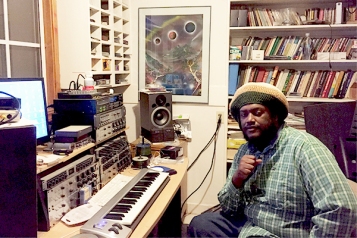
The festival this year reflected lines of descent, personal and musical. Nowhere was that clearer than in Kamasi Washington’s rowdy, retro, angry, rejoiceful Friday set in Kippie’s. His 2015 album, The Epic, celebrated the fiercely creative reunion of LA musicians who’d grown up together: community spirit and radical politics; Coltrane and funk; the church; rap & rhythm n’blues. Live, we got all of that and more: a performance that brought together those parts of the audience who wanted to move, and those who wanted to meditate, eyes tight shut, on a heavy solo. Washington’s set provoked and challenged people to move between the two categories – a unique moment.
Next day, at the record stall:
“Is this the music we heard last night? Why is it so expensive?”
“Yes – but the album has three hours of it.”
“You lie! Did you hear that? We have to buy this – it’s three times more!”
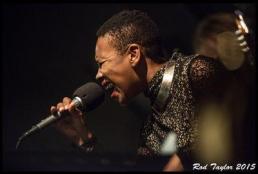
Siya Makuzeni is a musicians’ musician, as evidenced by the number of fellow-artists in the Rosie’s audience for her set. But, like Washington, she touches hearts as well as intellects, with deep roots in Xhosa vocal tradition. Where the grandmothers of Lady Frere village multiply their voices through choral overtones, Makuzeni uses digital loops to build up a layered host of healing sounds. Close your eyes, and it’s like a sculpture by Ayanda Mji, encrusted with bird-headed women: all singing.
Bird calls; Mahanthappa answers
Overtones, this time on a brass instrument, returned with saxophonist Rudresh Mahanthappa. His audience may have suffered from a shamefully early Saturday slot at Rosies – a consequence of the Thandiswa dilemma above – but the music suffered not one whit. For me, this was the performance of the festival: it should have closed the night, not opened it.
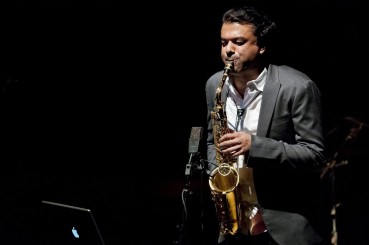
This is probably the final Bird Calls tour, and the rapport (and palpable humour and affection) the group has built up over time spoke powerfully from the stage. Mahanthappa’s homage to Parker is clever music carried by technically superb playing. It certainly demands thought – but there’s cold cerebral and then there’s hot cerebral. Bird Calls is definitely the latter, and in that defiantly assertive – and witty – intellectualism it truly captures the spirit of bebop without any of the retro-cliched junk. Francois Mouton is a quiet bassist: his ruthlessly steady lines hold the flying ideas together, his solos spin out on multiple ideas of his own. There were machine guns and metronomes from drummer Rudy Royston, while trumpeter Adam O’Farrill speaks equally fluently in both the lyrical and the bratty, speed-merchant voices of his instrument.
O’Farrill kept making me think of Clifford Brown, and that reference point persisted in Cape Town trumpeter Darren English’s Molelekoa set. On his debut release, Imagine Nation, English covers a tune made famous by Brown, Cherokee, which he has called “the pinnacle song for getting your chops up”. But English is no copyist: what impressed on stage was his fluent personal voice, bright, contained energy, and the freshness of his own compositions. It’s a pity he’s getting his (deserved) breaks in the US – we need to hear more of him here. The other discovery of English’s set was the compelling slow burn of emotion in the solos of saxophonist Gregory Tardy; the audience wanted more of those, too.

In some ways it was a festival of trumpets. Back at Rosie’s, Mandla Mlangeni with the Tune Recreation Committee gave us melodies such as Bhekisizwe that we already love, but more new songs from TRC’s latest release, Voices of Our Vision, with powerful lyrics delivered by Zoe Modiga. It’s interesting how Mlangeni’s compositions take on an entirely different character in his different outfits. Here, fresh spices and shading were added particularly by the jagged abstract explorations of pianist Yonela Mnana and the spacious, Metheny-ish – but distinctly Capetonian – landscapes painted by guitarist Keenan Ahrends.
It wasn’t Clifford Brown but Mongs that Mlangeni called up in some angry-hornet solos, and it must have been painful, in the weekend’s political context, to play Bhekisizwe, homaging a father who died for values no longer visible. Plaintive, descending notes from that melody seemed to keep coming back, in segues and improvisations – or maybe we just needed to hear those notes, as we did to chorus with Mlangeni on Afrika Mayibuye? Yet Voices of Our Vision also put strong new writing on display, such as the processional of (I’m So) True, slowly gathering obsessive pace.
Swiss chops and South African forests
Skyjack’s trombonist Andreas Tschopp certainly has chops, and we heard more of him in this Swiss/SA band’s set that we do on the album. But in Skyjack, it’s not just the players you can make easy puns about who have them. Kesivan Naidoo, Shane Cooper, Kyle Shepherd and reedman Marc Stucki all marry virtuoso technique with open, slightly quirky imaginations to produce something that genuinely merits the overused accolade ‘unique’. Maybe it’s the combination of cold North and warm South – or maybe it’s the blend of distinctive individual visions with apparently seamless shared ones? On a new number, The Hunter, for example, the relentless driving pulse of the tune was all kinds of hunting and being hunted, until Cooper’s and then Shepherd’s solo took the twisty path through a forest that ultimately turned out to be Knysna.
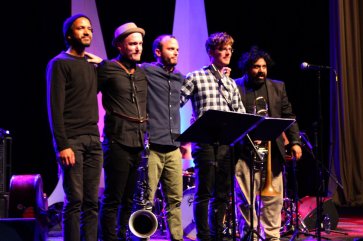
My festival closed with Escalandrum. Tango without bandoneon and dancers might seem as unthinkable as bacon (or Easter) without eggs, but these literal – in the case of leader, grandson Daniel ‘Pipi’ Piazzola – and spiritual descendants of tango pioneer Astor Piazzola made it work. Instead of watching flamboyant pasos and castigados, our ears tune to the delicate appeal of Astor’s compositions (Megadeath guitarist Marty Friedman has called them “shameless pop melodies”), and the scope they offer for imaginative, sometimes anarchistic, jazz improvisation. Pipi Piazzola has talked at length about his fascination with claves (the Latin rhythm patterns that overdetermine conventional meters ) and in this bandoneon-free zone, without that particular voice on top, listeners are drawn into his complex drum patterning. It’s a reminder that in Buenos Aires, African immigrants were among the working-class portenõs who built tango culture, and that tango, like the rest of the jazz family, has its share of African roots.
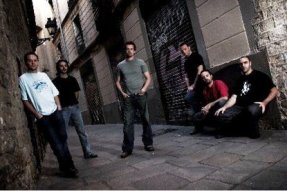
With so much good music to hear, the artists who stay most vividly in the memory have something important in common. It isn’t just that they played superbly – everybody this year did that. It’s that they also had something important to say.
The festival should be called a musical festival not a jazz festival.
LikeLike
Major media houses are usually divided into 4. (Print and broadcast media). News, sports, education and events/entertainment There are also subdivision on this 4 categories and I guess I guess when you talk of papers not having had reported on CTIJF you are now talking about the entertainment’s category of the press?
The answer is simple no one from the print media has the expertise to articulate or report about jazz or music like you do. Most of them will cover the jazz event from a tabloid point of view than the key points you’ve highlighted on your blog.
There’s a dearth in South Africa or the continent as a whole when in comes to music reviews. Imagazine what would happen if print and broadcast media were to invest on reporters who actually studied music to report on such events.
LikeLike
What a great multi-hued picture you’ve painted ! For a regular attendee who couldn’t make it this year, I am reassured that quality music and musicianship continues to be represented on the various stages at the CTJIF. And, of course, the perennial Kippies acoustic challenges and Rosies’ audience behaviour. Thank you so much 🙂
LikeLike
Thanks for the article. Pity you missed Jokko the where incredible
LikeLike
Reblogged this on AmaReflections.
LikeLike